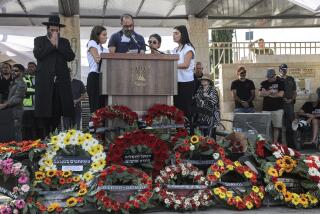Long Day in Beirut : Hopes Soar, Then Die at Schoolyard
BEIRUT — Thirty-five American hostages waited all day in a Beirut schoolyard for their expected freedom Saturday, only to see their hopes founder when Muslim militants holding the four remaining hostages from TWA Flight 847 failed to deliver them.
The disappointment came after Lebanese Shia Muslim leader Nabih Berri, who has been negotiating the hostages’ release, told reporters that he was awaiting a U.S. guarantee that there would be no Americans reprisals after the hostages were freed.
The 35 hostages were assembled in the heavily guarded schoolyard near Borj el Brajne, a bombed-out Palestinian refugee camp on Beirut’s southern outskirts where Shia and Palestinian forces fought a bloody five-week battle. They included the three-man flight crew of the Trans World Airlines 727 hijacked by Shia gunmen on June 14.
Waiting With Red Cross
The Americans waited with International Red Cross officials who had planned to escort them to Damascus, Syria, in 10 cars with a truck carrying their baggage.
John L. Testrake, pilot of the skyjacked aircraft, told reporters in the schoolyard, “We’ve been told we’re going to Damascus, but we’re still waiting for the last four to get here.”
The crew joined the other hostages Saturday morning at the Borj el Brajne Girls’ School, a Shia facility about a mile north of the beachfront airport. Passengers cheered and applauded when the crewmen were brought into the courtyard, and many shook their hands.
It was the first time they had seen each other since the end of the back-and-forth trip between Beirut and Algiers in the first days of the ordeal, during which more than 100 people aboard were freed. The passengers had been split up into groups, most apparently under Amal’s custody, in the Shia slums of south Beirut.
Taken on ‘Wild Ride’
Testrake, 57, who is from Richmond, Mo., told reporters that Shia militiamen took the three crewmen off the plane, the night before they were expected to be freed, for a “wild ride” that included a television interview and a bath at 3 a.m.
A senior official of the Shia militia Amal told a group of journalists that Amal was trying to secure the release of the four remaining hostages, who have been held by gunmen of Hezbollah (Party of God), a radical Shia faction believed to have planned the hijacking.
However, by 9:30 p.m., they had not appeared, and the journalists were told to leave amid apparent preparations for the hostages to be returned to the Beirut hideouts where they have been held since June 17.
Asked where the hostages would spend the night, an Amal official said, “That is Amal’s business.”
“Talk about bringing you all the way up and knocking you all the way down again,” said one of the hostages, John McCarthy of San Francisco.
Earlier, Akel Hamiyeh, Amal’s local military commander, told a reporter at the schoolyard, “We are having talks with the hijackers, who are holding the other four hostages.”
Asked why the hijackers were refusing to hand over the four men, he said, “They have many brothers among the 735 prisoners held by Israel, and they want them freed now.”
The four missing Americans, according to their comrades, are Robert G. Brown, 42, of Stow, Mass.; Richard Herzberg, 33, and Jeffrey Ingalls, 24, both of Virginia Beach, Va., and Robert Trautmann, 37, of Laredo, Tex.
Reporters spoke with the hostages inside the tree-shaded compound of the two-story school, ringed by Amal militiamen with truck-mounted machine guns. The Americans initially appeared relaxed, but as the day wore on they became grim-faced and agitated.
Before the journalists left, Allyn B. Conwell of Houston said the hostages had been on “an emotional roller coaster” during their 16 days of captivity.
“It’s been harrowing, frightening,” said Conwell, 39, who has been elected spokesman for the hostages. “It’s been an experience that I certainly don’t wish to go through again. Even more important than that, I don’t wish that anyone would have to go through this.”
He added, however, that the treatment of the Americans has been “almost unique in the theater of hostage situations. We’ve been in relatively comfortable surroundings.
“The overall attitude of the Amal militia people who have held us in custody for the last two weeks since we got off the airplane has been . . . very comfortable from the physical standpoint,” he said.
Conwell said he found himself acting as the contact between the various groups of hostages and their captors.
“As elected spokesman, I’ve had more opportunity than the rest to get around and verify the health and well-being of the rest of the hostages,” he said. “I’ve been called upon by several of the groups to try to rectify certain situations that they found to be uncomfortable, and it’s been always that I found a great amount of cooperation from the Amal people. They’ve treated us graciously.”
Blake Synnestvedt, 24, of Bryn Athyn, Pa., who was on his honeymoon when the plane was hijacked on a flight from Athens to Rome, said: “I’ve been away for as long as we’ve been married. I don’t see any problem in adjusting. Once I get home, we’ll just pick up where we left off.”
His wife was released in Algiers during one of the two stops that the hijacked plane made there before settling in Beirut.
Pilot Testrake said he was concerned about his aircraft during the Friday night outing.
“We’d left all the electrical systems and the air conditioning systems operating, and here it was several hours later and they were still running unattended,” he said. “There were still the guards on board, but they don’t understand anything about the aircraft.
“I told the fellow he was in danger of losing the airplane, and he just said it’ll be OK until morning. So we went to sleep.”
Testrake said he mentioned it again Saturday morning, “and they said they’d like us to check the airplane to see if it was flyable.”
More to Read
Sign up for Essential California
The most important California stories and recommendations in your inbox every morning.
You may occasionally receive promotional content from the Los Angeles Times.










